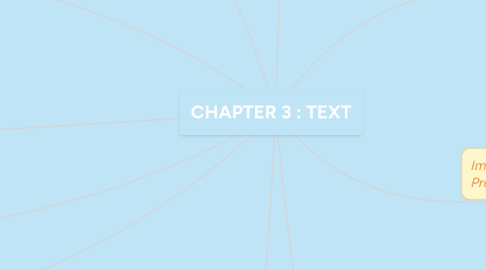
1. Text Elements
1.1. Menus for navigation
1.1.1. A user navigates through content using a menu
1.1.2. A simple menu consists of a text list of topics.
1.2. Interactive buttons
1.2.1. A button is a clickable object that executes a command when activated
1.3. Fields for reading
1.3.1. Reading a hard copy is easier and faster than reading from the computer screen.
1.4. HTML documents
1.4.1. Hypertext Markup Language
1.4.2. standard markup language used to create web pages.
1.4.3. marked using tags
1.4.4. collection of technologies used together to create interactive and animated web sites
1.5. Symbols and icons
1.5.1. Symbols are concentrated text in the form of stand-alone graphic constructs.
1.5.2. Icon – symbolic representations of objects and processes
1.5.3. Symbol– represents products or ideas
2. Rasterization
2.1. The process of converting text from a vector description to a raster or bitmap description
2.2. The jagged edges you see when a bitmapped image is resized
3. Anti-aliasing
3.1. Antialiasing blend the font into the background color
4. Font Mapping
4.1. Some fonts installed in your machine may not be available in other user’s machine.
5. Font Editing and Design Tool
5.1. Fontographer is a specialized graphics editor
5.2. It can also modify existing typefaces and incorporate PostScript artwork
6. Hypertext vs Hypermedia
6.1. Hypertext: text which contains links to other texts
6.2. Hypermedia: not constrained to be text-based
6.2.1. Navigating hypermedia structures
6.2.1.1. The simplest way to navigate hypermedia structures is via buttons
6.2.2. Hypermedia structures
6.2.2.1. Links
6.2.2.1.1. connections between conceptual elements.
6.2.2.2. Nodes
6.2.2.2.1. accessible topics, documents, messages, and content elements.
7. Importance of Text in a Multimedia Presentation
7.1. The simplest of data types and requires the least amount of storage
7.2. Text in the form of symbols, words, sentences, and paragraphs.
7.3. Vital element of multimedia menus, navigation systems, and content.
8. Typeface & fonts
8.1. typeface
8.1.1. family of graphic characters, often with many type sizes and styles.
8.1.2. Example : Bookman Old Style
8.2. Fonts
8.2.1. collection of characters of a single size and style belonging to a particular typeface family.
8.2.2. Example : Arial 18 point Bold
8.3. fonts and typefaces includes
8.3.1. Font styles
8.3.1.1. Boldface/Italic/Underlining/Outlining
8.3.2. Font terminology
8.3.2.1. Baseline – the line on which the bases of characters are arranged
8.3.2.2. Cap height - cap height refers to the height of a capital letter
8.3.2.3. x-height – the distance between the baseline and the top of a lower-case letter x
8.3.2.4. Ascenders/descenders – strokes that rise above the x-height/drop below the baseline
8.3.2.5. Kerning – adjustment of space between certain pairs of letters (e.g. AV) to make them look more uniform
8.3.2.6. Tracking - adjustment of space for groups of letters
8.3.2.7. Serif versus sans serif
8.3.2.7.1. Serif –little decoration at the end of a letter stroke
8.3.2.7.2. Sans serif –fonts do not have decoration at the end of a letter stroke
8.3.3. Cases
8.3.3.1. A capitalized letter is referred to as uppercase, while a small letter is referred to as lowercase
9. Bitmap vs Vector
9.1. Bitmaps Font
9.1.1. consist of a matrix of dots or pixels representing the image
9.1.2. File size increases as more sizes are added
9.1.3. Require a lot of memory
9.1.4. Non-scalable
9.2. Vector fonts
9.2.1. drawing use instructions and mathematical formulae to describe each glyph
9.2.2. File size is much smaller than bitmaps
10. Computers and Text
10.1. Character sets
10.1.1. Each character is represented by a unique 7-bit binary code word, meaning that there are 128 (27) alternative characters
10.2. Extended Character Set (ISO Latin-1)
10.2.1. Extra 1 bit in ASCII –up to 256 characters is used while
10.2.2. EXAMPLE:¢ ä ü
10.3. Unicode
10.3.1. Unicode is a 16-bit architecture for multilingual text and character encoding
10.3.2. covers 96,382 characters

